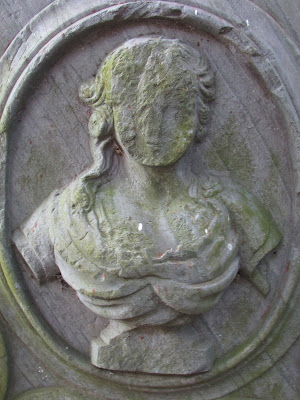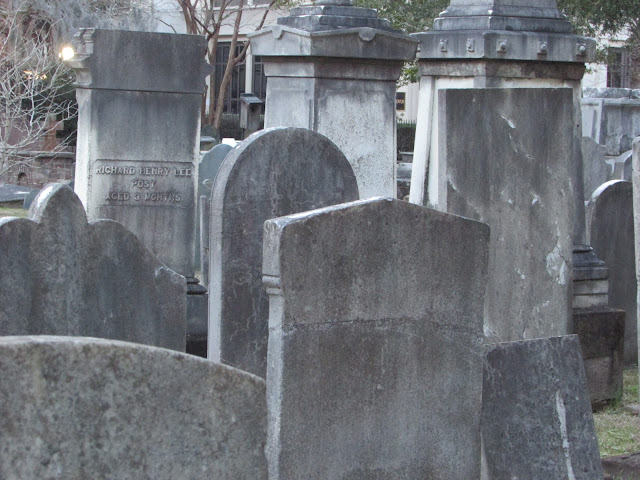"soul effigies"
What are "soul effigies"? I think the earlier carvings didn't look like cute "cherubs" or sweet angels. The earlier ones were more skulls and crossbones known as "death's heads"and some of the more gruesome ones from Puritan times had bones, caskets, the skulls, and even picks and axes, used the dig the grave! Skulls were common in the 1600s and this cemetery was here then.
People began to replace the more sinister looking skulls, crossbones etc. and using the angels and winged creatures, because they were more nice to look at and portrayed death in a better outlook, with hope of an afterlife. Besides, the little cherubs had a childlike quality and were more innocent looking than the grim death skulls that had been used before. Once I understood this, I knew if I was looking at "newer" or older (closer to the end of the 18th century) stones, simply by the types of carvings.
Symbols carved into the stones had meaning back then. For instance, although a big snake looks scary on a stone, it actually means eternal life. A snake all wrapped around a Christian cross symbolizes the Masonic snake. The evil looking skull and crossbones simply meant that death comes to all of us--a "menento Mori," a reminder of our own mortality. Religious symbols were certainly used, as were symbols and drawings telling about the person who was laid to rest there, such as their profession and social class, or beliefs, membership in fraternal organizations, and things like swords, doves, leaves, books, flames, wheat, sickles, flowers,horse shoes (protection from evil--or the deceased might've just loved horses!) trees, etc. Willow trees stand for human life. And no--skulls and bones DID NOT mean that a pirate was buried there. Upside down torches and hourglasses with wings meant that life ends too soon. Two joined hands show that love continues even after death. Beautiful moons, suns and stars mean that Heaven is up in the sky. Doves are seen in both Christian and Jewish cemeteries.

Many of our gravestone carvings here in Charleston are like the ones in New England. Some of the stones are so interesting (well, to me, ALL OF THEM are interesting! LOL), and even tell what the person died from. I often see ones here that say "died from yellow fever" and such.
We come across many, many graves marked by little lambs, those are on children's graves. Sadly, sicknesses, plagues and accidents claimed so many children back then, due to disease and unsanitary city conditions. Another thing I've seen many many times are stones that say something like "born December 1, 1722, Died December 1, 1722". Death is sad for anyone, but particularly sad for the families of the little children taken so soon. So many babies died right at birth, many times tragically right along with their mothers. Childbirth was a serious and risky thing back then!They just did not have the medical knowledge we have today.
When the Victorian garden cemeteries became popular during the late 1800s, beautifully carved, ( sometimes life size or larger,) angels depicted sadness and grief, but also gave the bereaved family members some comfort with their beauty. Angels represent the flight of the soul going to Heaven. Calla lilies during this era represented beauty and marriage. Cemeteries changed during this era, and huge and excessive gravestones with lots of ornamentation, huge tall monuments, crypts and statues were so fashionable. Cemeteries were now like parks, and people often visited to picnic, bicycle, walk, and visit as they are filled with paths, pretty gardens, and wildlife. There were no more "skull and cross bones".
Once you learn what the scary looking symbols and carvings mean, cemeteries are much less morbid "scary" places.
(below, people on stones):
Carving likenesses into gravestones was a lucrative business in the old times. Skilled stone masons did very intricate carvings. The best supply of granite was up in Vermont, and most of the stone masons there were Scottish and Italian immigrants. Most of the most delicate work was done by the Italians, who had trained in Milan. These men were in HIGH DEMAND, as not many had the skills to do the most delicate and intricate carvings. Walking around old cemeteries, I can see why their work was definetly considered an art form. Much of it is very beautiful!
I think marble and limestone was used at first, (well, after, wood markers, which are now gone with weather and the passage of time) then granite became the most often used material. (Stones carved into slate are difficult or next to impossible to read now.) Bronze is also long lasting.
|

















































How beautiful the cemetery is and well kept. Love, Love the brick building...thanks for sharing.
ReplyDeleteYour walks are always so interesting Debbi! I love walking through old cemeteries and that is such interesting information about the carvings and their history. My grandmother had two babies who were born and died on the same day and their little graves are on each side of my grandfather's grave.
ReplyDeletei envy your glorious walks, i can't wait until it warms up here in new jersey. i don't mind the winter but we have gotten very little snow and that's what i enjoy most about winter!!
ReplyDeletei am not a fan of cemeteries, and i usually enjoy everything you share, but i don't go to cemeteries unless i have to. i LOVE that white blouse, that is my style and i would have purchased it!!!
fun stuff today!!
I love to visit old cemeteries as they are so interesting and many tell a story. I live where there are quite a few from the Revolutionary War and the beginning of our country. However, I found the most interesting in your Charleston and on my trips there, we have always visited some.
ReplyDeleteWhat a wonderful tour of the area,Debbi. I really love all your pictures. I have always been drawn to old cemeteries. I grew up right next to one and always found it to be a peaceful place-nothing scary at all. Love the blouse, too, and the gold horse, too. xo Diana
ReplyDeleteThis is a fascinating post, Debbi. I really do love cemeteries (so long as I'm not to be in one anytime soon.) Very peaceful and interesting. I should look up the gravestone decoration on my great grandmother's. You inspired me.
ReplyDeleteCircular Church Graveyard is one of my favorites. It's a magical, mystical place. We must walk it together sometime soon! Before it gets too hot, haaaahaa xoxo
ReplyDelete